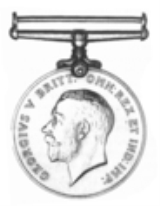
British War Medal
Encyclopedia
The British War Medal was a campaign medal of the British Empire
, for service in World War I
.
The medal was approved in 1919, for issue to officers and men of British and Imperial forces who had rendered service between 5 August 1914 and 11 November 1918. Officers and men of the Royal Navy
, Royal Marines
, and Dominion and Colonial naval forces (including reserves) were required to have completed 28 days mobilised service – the medal was automatically awarded in the event of death on active service before the completion of this period.
The medal was later extended to cover the period 1919–20 and service in mine-clearing at sea as well as participation in operations in North and South Russia, the eastern Baltic, Siberia, the Black Sea, and the Caspian.
Some 6,500,000 medals were awarded in total, of which 110,000 were bronze. These bronze medals were mostly issued to Chinese, Maltese, and Indians who served in labour battalion
s.
British Empire
The British Empire comprised the dominions, colonies, protectorates, mandates and other territories ruled or administered by the United Kingdom. It originated with the overseas colonies and trading posts established by England in the late 16th and early 17th centuries. At its height, it was the...
, for service in World War I
World War I
World War I , which was predominantly called the World War or the Great War from its occurrence until 1939, and the First World War or World War I thereafter, was a major war centred in Europe that began on 28 July 1914 and lasted until 11 November 1918...
.
The medal was approved in 1919, for issue to officers and men of British and Imperial forces who had rendered service between 5 August 1914 and 11 November 1918. Officers and men of the Royal Navy
Royal Navy
The Royal Navy is the naval warfare service branch of the British Armed Forces. Founded in the 16th century, it is the oldest service branch and is known as the Senior Service...
, Royal Marines
Royal Marines
The Corps of Her Majesty's Royal Marines, commonly just referred to as the Royal Marines , are the marine corps and amphibious infantry of the United Kingdom and, along with the Royal Navy and Royal Fleet Auxiliary, form the Naval Service...
, and Dominion and Colonial naval forces (including reserves) were required to have completed 28 days mobilised service – the medal was automatically awarded in the event of death on active service before the completion of this period.
The medal was later extended to cover the period 1919–20 and service in mine-clearing at sea as well as participation in operations in North and South Russia, the eastern Baltic, Siberia, the Black Sea, and the Caspian.
Some 6,500,000 medals were awarded in total, of which 110,000 were bronze. These bronze medals were mostly issued to Chinese, Maltese, and Indians who served in labour battalion
Labour battalion
Labour battalions have been a form of alternative service or unfree labour in various countries in lieu of or resembling regular military service...
s.
Description
- The medal is a circular silverSilverSilver is a metallic chemical element with the chemical symbol Ag and atomic number 47. A soft, white, lustrous transition metal, it has the highest electrical conductivity of any element and the highest thermal conductivity of any metal...
(or, in rare cases, bronzeBronzeBronze is a metal alloy consisting primarily of copper, usually with tin as the main additive. It is hard and brittle, and it was particularly significant in antiquity, so much so that the Bronze Age was named after the metal...
) design. The obverse shows a King George VGeorge V of the United KingdomGeorge V was King of the United Kingdom and the British Dominions, and Emperor of India, from 6 May 1910 through the First World War until his death in 1936....
bareheaded effigy, facing left, with the legend: GEORGIVS V BRITT : OMN : REX ET IND : IMP : (George 5th, King of all the Britains, and, Emperor of India) - The reverse shows St. George, naked, on horseback armed with a short sword (an allegory of the physical and mental strength which achieves victory over Prussianism). The horse tramples on the PrussianKingdom of PrussiaThe Kingdom of Prussia was a German kingdom from 1701 to 1918. Until the defeat of Germany in World War I, it comprised almost two-thirds of the area of the German Empire...
shield and the skull and cross-bones. Just off-centre, near the right upper rim, is the sun of Victory. The dates 1914 and 1918 appear in the left and right fields respectively. - The ribbon has a wide central watered stripe of orange, flanked by two narrow white stripes, which are in turn flanked by two black pin-stripes, further flanked by two outer stripes of blue. The colours are not believed to have any particular significance.
See also
- World War One - Medal AbbreviationsWorld War One - Medal Abbreviations-World War I - Medal and Medal Card Abbreviations:When a World War I medal was issued, it was issued with a Service Number, Rank, Name and Regiment. This information should be on every medal that was issued during the First World War....
- British campaign medalsBritish campaign medalsBritish campaign medals are awarded to members of the British Armed Forces, Allied forces and civilians participating in specified military campaigns...
- Australian campaign medalsAustralian campaign medalsAustralian campaign medals in order of precedence as defined in references below. Those campaign medals which have been independently issued by Australia to its armed forces are in bold.-South African War:* Queen's South Africa Medal...
- New Zealand campaign medalsNew Zealand campaign medalsPrior to 1946 the New Zealand armed forces received honours of the United Kingdom, including military decorations and campaign medals. Since the end of World War 2 there have been constant moves towards an independent New Zealand honours system...

